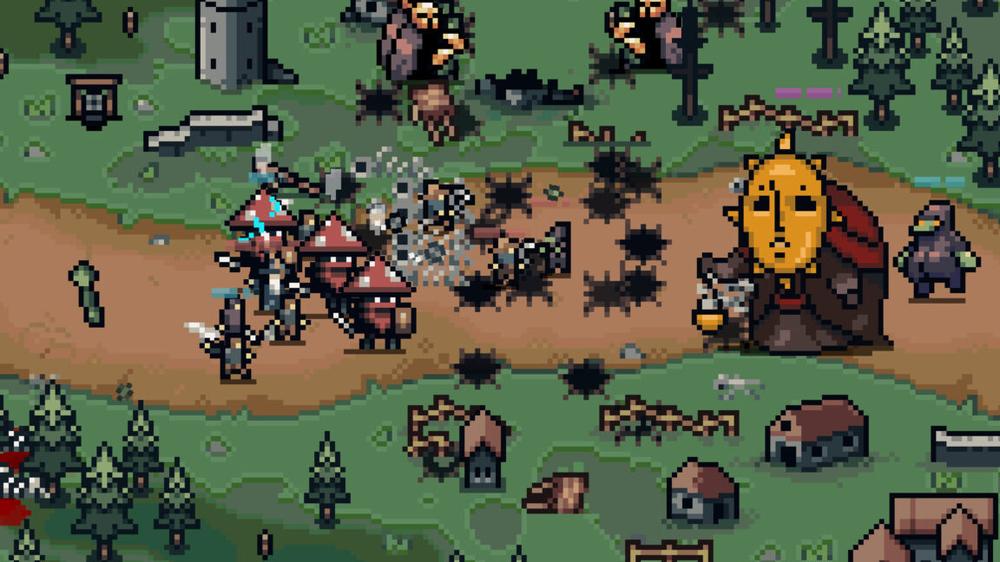As satisfying as a successful real-time strategy game campaign can be, dealing with a complex RTS map can often be overwhelming. Keeping track of multiple far-flung resource-production bases, groups of units, upgrade trees, and surprise encounters with the enemy requires a level of attention-splitting that can strain even the best multitaskers.
Then there's The King is Watching, which condenses the standard real-time strategy production loop into an easy-to-understand single-screen interface, complete with automatic battles. The game's unique resource management system—combined with well-designed, self-balancing difficulty and randomized upgrades that keep each run fresh—makes The King is Watching one of the most enjoyable pick-up-and-play strategy titles I've encountered in a long time.
What is the king watching, exactly?
The bulk of the action in The King is Watching takes place on a small, 4x4 grid of squares representing your castle. That's where you'll place blueprint tiles from your hand that then start producing the basic and refined resources necessary to place even more blueprints. Those resources also power the factories that crank out defensive units that automatically fight to protect your castle from periodic waves of enemies (in adorable pixelated animations that take place on a battlefield to the right of your castle).
Sounds simple enough. But the entire castle can't be actively productive at once. Instead, only a few contiguous tiles within the area of the "king's gaze" can make resources and/or units at any one time.
That means you have to constantly and actively drag and rotate your "gaze" around your castle, prioritizing the resources and units you need immediately and leaving others that can wait for the king's attention. You have to be careful with the relative positioning of your blueprints so that units and resources that complement each other can be produced in the same "gaze" without a lot of unproductive downtime (say, when you've hit your unit limit) or resource droughts.
You might start off with one corner of the grid devoted to basic resources and another to basic unit production, shifting your gaze quickly between the two as your unit numbers and/or resource stockpiles dwindle. Later, you might add a market to generate the gold you'll need for the squares that produce stronger units or a crystal mine that will help supply powerful magical units you create later in the run.
You might also invest your treasure in upgrades that make certain tiles produce more quickly or on global upgrades that expand your gaze or let you station more troops on the field at once. And as your grid fills up, you must figure out which underpowered or less-useful tiles to destroy to make space for the more powerful blueprints you've hopefully earned or generated to replace them.
Try to keep up
Shifting your gaze and adjusting your production tiles plays out like a simple puzzle game, requiring effective juggling of both time and space to be maximally efficient. You need to constantly split your attention between your present resource and unit needs and your near- and far-future plans for upgrades. As frantic as this can get, it never feels unmanageable, thanks in large part to an excellent user interface that packs practically everything you need to know onto a single screen, no camera-fiddling or complex keyboard shortcuts required.
The King is Watching also makes use of an ingenious kind of partially self-selecting difficulty system, where you periodically pick from a randomized set of "prophecies" to "predict" how many and which enemies will come in the next few waves (and which potential upgrades they might give you when they're gone). This leads to a delightfully fraught balance of risk and reward, forcing you to ride the edge of survivability in each wave. Choose too many enemies and you could be overwhelmed before your defensive units are built up. Choose too few and you won't earn the requisite upgrades needed to work through the overpowered boss waves later.
Those inter-wave upgrades are also randomized in each run, adding some roguelike unpredictability that means no two play sessions develop quite the same way. You have to be flexible, adapting to the blueprints and units you're given, while being willing to abandon plans that are no longer feasible.
Between waves, you'll often get the opportunity to buy emergency resource drops, useful upgrades that last through the whole run, or one-time spells that can strengthen your units or hinder the opposition. Figuring out the best potential upgrade paths requires a lot of trial and error, and you'll need a little luck in drawing some of the more powerful upgrade options. While experience and skill can make things more manageable, some runs end up a lot more winnable than others.
Playing through successful waves also earns you tokens you can spend between runs on permanent upgrades (including crucial expansions of that 4x4 grid) and new selectable kings with their own unique gaze shapes and special powers. But even as these upgrades make it easier to succeed in successive runs, the game cranks up the "threat level" in turn to raise the enemy strength level (and the stakes) accordingly.
That kind of self-balancing means The King is Watching always manages to feel engaging without coming off as totally unfair. And individual runs are zippy enough to not wear out their welcome; you can make it through a full run of two or three bosses in about 30 minutes or so, especially if you use the "fast forward" option to speed up the routine resource production between enemy waves.
Best of all, those 30 minutes are so dense with important decisions and split-second management of your kingly gaze that you never have time to feel bored. The King is Watching perfectly rides the fine line between engrossing and overwhelming, making it perfect for quick, lunch-break-sized brain breaks that combine positional reasoning, reflexes, and strategic planning.

 Apple ha fame di IA e valuta acquisizioni di peso nel settore dopo i risultati record del trimestre
Apple ha fame di IA e valuta acquisizioni di peso nel settore dopo i risultati record del trimestre